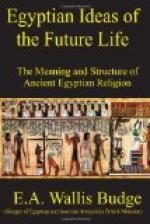It has been said above that the idea of the judgment of the dead is of very great antiquity in Egypt; indeed, it is so old that it is useless to try to ascertain the date of the period when it first grew up. In the earliest religious texts known to us, there are indications that the Egyptians expected a judgment, but they are not sufficiently definite to argue from; it is certainly doubtful if the judgment was thought to be as thorough and as searching then as in the later period. As far back as the reign of Men-kau-R[=a], the Mycerinus of the Greeks, about B.C. 3600, a religious text, which afterwards formed chapter 30B of the Book of the Dead, was found inscribed on an iron slab; in the handwriting of the god Thoth, by the royal son or prince Herut[=a]t[=a]f. [Footnote: See Chapters of Coming Forth by Day, Translation, p. 80.] The original purpose of the composition of this text cannot be said, but there is little doubt that it was intended, to benefit the deceased in the judgment, and, if we translate its title literally, it was intended to prevent his heart from “falling away from him in the underworld.” In the first part of it the deceased, after adjuring his heart, says, “May naught stand up to oppose me in the judgment; may there be no opposition to me in the presence of the sovereign princes; may there be no parting of thee from me in the presence of him that keepeth the Balance!... May the officers of the court of Osiris (in Egyptian Shenit), who form the conditions of the lives of men, not cause my name to stink! Let [the judgment] be satisfactory unto me, let the hearing be satisfactory unto me, and let me have joy of heart at the weighing of words. Let not that which is false be uttered against me before the Great God, the Lord of Amentet.”
Now, although the papyrus upon, which this statement and prayer are found was written about two thousand years after Men-kau-R[=a] reigned, there is no doubt that they were copied from texts which were themselves copied at a much earlier period, and that the story of the finding of the text inscribed upon an iron slab is contemporary with its actual discovery by Herut[=a]t[=a]f. It is not necessary to inquire here whether the word “find” (in Egyptian qem) means a genuine discovery or not, but it is clear that those who had the papyrus copied saw no absurdity or impropriety in ascribing the text to the period of Men-kau-R[=a]. Another text, which afterwards also became a chapter of the Book of the Dead, under the title “Chapter of not letting the heart of the deceased be driven away from him in the underworld,” was inscribed on a coffin of the XIth dynasty, about B.C. 2500, and in it we have the following petition: “May naught stand up to oppose me in judgment in the presence of the lords of the trial (literally, ’lords of things’); let it not be said of me and of that which I have done, ’He hath done deeds against that which is very right and true’; may




